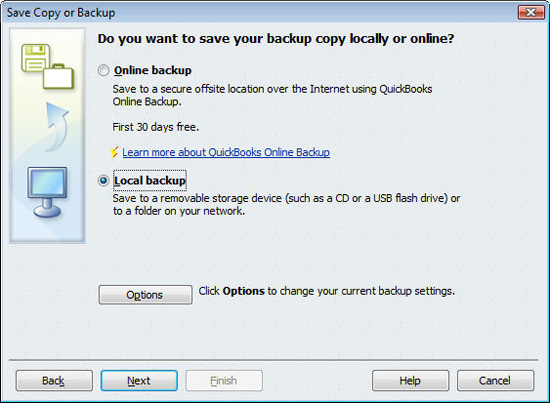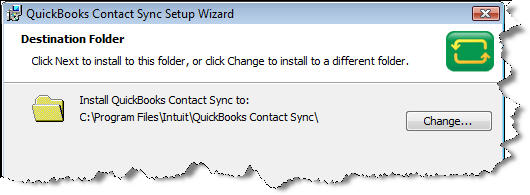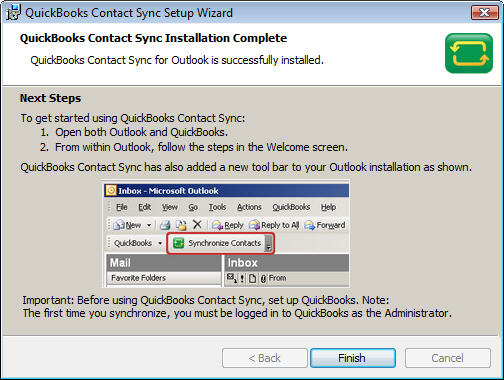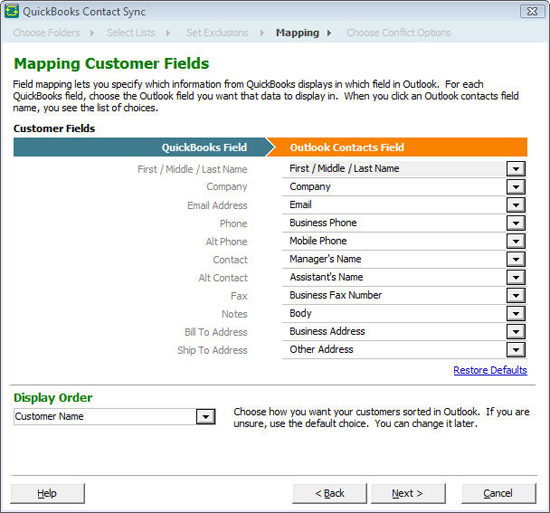Save Time and Reduce Mistakes by Synchronizing Your Data
The New Year’s here, the Christmas bills are rolling in, and income taxes loom. Maybe you can’t save money just now, but how about an easy way to save time and keystrokes? If you use Microsoft Outlook 2003, 2007 or 2010 for contact management and QuickBooks Pro, Premier, or Enterprise 2005 and up for financial management, you can synchronize data to avoid entering the same contact information twice.
It’s easy, but you need to take care to follow instructions precisely anytime you’re integrating multiple databases. You can’t unring that bell. Start by backing up your data in each program, as shown in Figure 1. For Outlook, check your help files; the data file format changed in 2003. QuickBooks users should use the program’s standard built-in tools by clicking File|Save Copy or Backup. You can either save your QuickBooks file locally (to a CD or USB flash drive) or use QuickBooks Online Backup (30-day free trial; starts at $4.95/month for 5 GB).

Figure 1: It’s very important that you back up your Outlook and QuickBooks files before you synchronize.
Get in Sync
QuickBooks lets you synchronize three kinds of contact information with Outlook:
- Customer contact information contained in your Customer & Jobs list
- Vendor contact information from your Vendor list
- Contact information on your Other Names list
Note: You can’t synchronize employee contact information.
To get started, click File|Utilities|Synchronize Contacts. QuickBooks Contact Sync must be installed on your PC before you do your first sync. When the window shown in Figure 2 opens, click OK and follow the instructions for downloading and installing.

Figure 2: QuickBooks provides a wizard that walks you through the process of downloading and installing QuickBooks Contact Sync.
QuickBooks will prompt you to shut down Outlook before you start, if you haven’t already done so. When the installation is finished, you’ll see the window shown inFigure 3. And you’ll notice that the installation has added a new toolbar to your copy of Outlook.

Figure 3: QuickBooks tells you when your QuickBooks Contact Sync has installed properly.
Click Finish and restart Outlook. You’ll see a window titled QuickBooks Contact Sync for Outlook (this can be disabled once you’ve gone through the initial import by unchecking the box in the lower left corner). Make sure you’re logged into QuickBooks as the Administrator and that the company file you want to synchronize is open.
Click Get Started. A box that says Connecting to QuickBooks will open, and there’ll be a short delay. After the connection is made, the Begin Setup window opens. Click the Setup button to launch the wizard. If you have more than one Outlook contact file (for example, if you use Outlook with Business Contact Manager), you’ll have to select the file you want to sync.
Click Next. The next screen asks you to specify which contact types you want to sync (customers, customer jobs, and/or vendors). If any of your contacts are personal, you can choose to exclude those. Click Next after each of those screens.
QuickBooks Contact Sync includes a mapping tool, which helps ensure that the correct fields in each program are matched. For example, Company in one program should “map” to Company in the other as shown in Figure 4.

Figure 4: QuickBooks Contact Sync helps you make sure that fields in each program “map” accurately to each other.
The final step in the setup process is critical if you don’t want to lose important data, so choose the next option carefully. You need to tell QuickBooks Contact Sync what to do if the same contact exists in both programs but their properties are not exactly the same. Your options:
[checklist]
- Let the Outlook data win
- Let the QuickBooks data win
- Decide in each individual case
[/checklist]
Once you’ve made your selection, click Save. If you want to go back over any of these settings, click Setup. Otherwise, click Cancel or Sync Now.
After you’ve completed the first synchronization, you’ll need to perform a manual sync each time you want to make the databases match. To do so, click theQuickBooks ContactSync menu in Outlook. This menu provides a number of options, including Preferences.
Sync Now and Save Time Later
Saving time these days is saving money. You can use those extra minutes (or hours) to build your business instead of always having to worry about running it.QuickBooks Contact Sync can give you some of those extra minutes, help you avoid frustration, and aid in keeping your databases clean and up to date.








